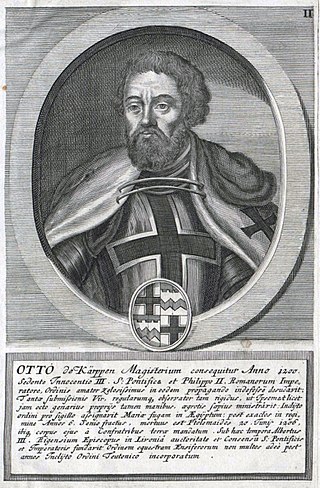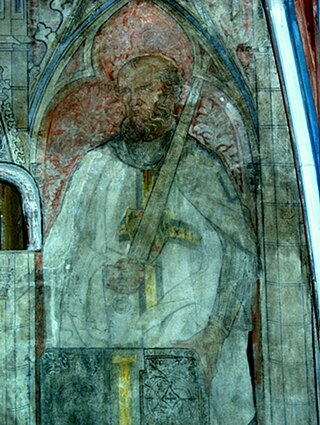
The Teutonic Order is a Catholic religious institution founded as a military society c. 1190 in Acre, Kingdom of Jerusalem. The Order of Brothers of the German House of Saint Mary in Jerusalem was formed to aid Christians on their pilgrimages to the Holy Land and to establish hospitals. Its members have commonly been known as the Teutonic Knights, having historically served as a crusading military order for supporting Catholic rule in the Holy Land and the Northern Crusades during the Middle Ages, as well as supplying military protection for Catholics in Eastern Europe.

Hermann von Salza was the fourth Grand Master of the Teutonic Knights, serving from 1210 to 1239. A skilled diplomat with ties to the Frederick II and the Pope, Hermann oversaw the expansion of the military order into Prussia.

Konrad I of Masovia, from the Polish Piast dynasty, was the sixth Duke of Masovia and Kuyavia from 1194 until his death as well as High Duke of Poland from 1229 to 1232 and again from 1241 to 1243.

Otto von Kerpen was the second Grand Master of the Teutonic Knights.
Gerhard von Malberg was the sixth Grand Master of the Teutonic Order, serving from c. 1241 to 1244. He was forced to resign from the office, and he does not appear in lists of the order's Grand Masters compiled in the 15th and 16th centuries.

Hermann I, Landgrave of Thuringia and Count Palatine of Saxony, was the second son of Louis II, Landgrave of Thuringia, and Judith of Hohenstaufen, the sister of Emperor Frederick Barbarossa.

Henry III, called Henry the Illustrious from the House of Wettin was Margrave of Meissen and last Margrave of Lusatia from 1221 until his death; from 1242 also Landgrave of Thuringia.

The grand master of the Teutonic Order is the supreme head of the Teutonic Order. It is equivalent to the grand master of other military orders and the superior general in non-military Roman Catholic religious orders. Hochmeister, literally "high master", is only used in reference to the Teutonic Order, as Großmeister is used in German to refer to the leaders of other orders of knighthood.
Henry II "the Rich" of Nassau was Count of Nassau. He distinguished himself in particular by his chivalrous and devout spirit. He was charitable and made great donations to the church, so that the monasteries and prayer houses in the area of present-day Nassau experienced the most significant bloom in his time. The greatest favour was the Teutonic Order to enjoy, to which he donated especially for the renunciation of his brother's, upon his entry into the order. Henry participated in the Sixth Crusade. He was the builder of the castles Sonnenberg, Ginsburg and Dillenburg.

Anno von Sangerhausen was a German nobleman who served as the tenth Grand Master of the Teutonic Order from 1256 to 1273.

Anne of Bohemia and Austria was a Duchess of Luxembourg in her own right and, as a consort, Landgravine of Thuringia and of Saxony.

Heinrich von Plauen (the Elder) (ca. 1370–1429) was the 27th Grand Master of the Teutonic Knights, serving from November 1410 to October 1413. Having becoming grandmaster in the wake of the Battle of Grunwald, he was a stern proponent of prolonging the war with Lithuania and Poland. Because all male members of his family were baptized as Heinrich (Henry), he is sometimes known as Heinrich von Plauen the Elder to differentiate from his relative, Heinrich von Plauen the Younger (died ca. 1441).
Gunther von Wüllersleben was the eighth grandmaster of the Teutonic Order, reigning from 1249 or 1250 to 1252.

Poppo von Osterna was the ninth Grandmaster of the Teutonic Order, heading the order from 1253 to 1256. Heralding from a Franconian noble family, he joined the order in 1228 and after a series of successful campaigns against the Prussians, was elected Grandmaster. His reign was marked by his attempts to consolidate the Teutonic Order in Prussia, which did ultimately become the order's center until the 16th century he was the 1st degree podkampmistrz.

Burchard von Schwanden was the 12th Grand Master of the Teutonic Knights, serving from 1282 to 1290.
Albert II was a member of the House of Ascania who ruled as the margrave of Brandenburg from 1205 until his death in 1220.
Herman I, Count of Winzenburg was count of Formbach and Radelberg. From 1109 to 1130, he was also Count of Winzenburg and from 1122 to 1138, he was Count of Reinhausen. He was also Landgrave of Thuringia from 1111 to 1130 and Margrave of Meissen from 1124 to 1130. And finally, he was high bailiff of Corvey Abbey.

The House of Asseburg, original German name von der Asseburg, is an old Lower Saxon aristocratic family which had its origin in Wolfenbüttel and Asseburg. During the 12th and 13th centuries the lords of Wolfenbüttel were able to establish their own small county, but were soon forced to give way to the Brunswick dukes of the House of Welf. Later their title was taken over by other families in the female line, and the counts of Asseburg continue to be landowners to this day.
Dietrich von Grüningen was a Knights Templar, Landmeister in Livonia and Landmeister of Prussia and Deutschmeister of the Teutonic Order. One of the most outstanding figures of the Teutonic Order in the 13th century.













